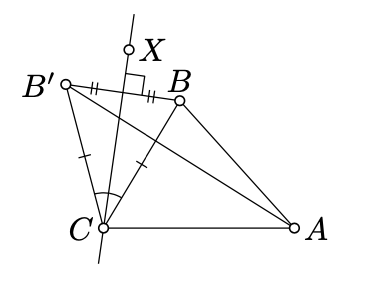11.3: Three angles of triangle
- Page ID
- 23649
Let \(\triangle ABC\) and \(\triangle A'B'C'\) be two triangles in the neutral plane such that \(AC = A'C'\) and \(BC = B'C'\). Then
\(AB < A'B'\) if and only if \(|\measuredangle ACB| < |\measuredangle A'C'B'|\).
- Proof
-

Without loss of generality, we may assume that \(A = A'\), \(C = C'\), and \(\measuredangle ACB\), \(\measuredangle ACB' \ge 0\). In this case we need to show that
\(AB < AB' \Leftrightarrow \measuredangle ACB < \measuredangle ACB'.\)
Choose a point \(X\) so that
\(\measuredangle ACX = \dfrac{1}{2} \cdot (\measuredangle ACB + \measuredangle ACB').\)
Note that
- \((CX)\) bisects \(\angle BCB'\).
- \((CX)\) is the perpendicular bisector of \([BB']\).
- \(A\) and \(B\) lie on the same side of \((CX)\) if and only if
\(\measuredangle ACB < \measuredangle ACB'\).
From Exercise 5.2.1, \(A\) and \(B\) lie on the same side of \((CX)\) if and only if \(AB < AB'\). Hence the result.
Let \(\triangle ABC\) be a triangle in the neutral plane. Then
\(|\measuredangle ABC| + |\measuredangle BCA| + |\measuredangle CAB| \le \pi.\)
The following proof is due to Legendre [12], earler proofs were due to Saccheri [16] and Lambert [11].
- Proof
-
Set
\(\begin{array} {rclcrclcrcl} {a} & = & {BC,} & \ \ \ \ \ & {b} & = & {CA,} & \ \ \ \ \ & {c} & = & {AB,} \\ {\alpha} & = & {\measuredangle CAB,} & \ \ \ \ \ & {\beta} & = & {\measuredangle ABC,} & \ \ \ \ \ & {\gamma} & = & {\measuredangle BCA.} \end{array}\)
Without loss of generality, we may assume that \(\alpha, \beta, \gamma \ge 0\).

Fix a positive integer \(n\). Consider the points \(A_0, A_1, ..., A_n\) on the half-line \([BA)\), such that \(BA_i = i \cdot c\) for each \(i\). (In particular, \(A_0 = B\) and \(A_1 = A\).) Let us construct the points \(C_1, C_2, ..., C_n\), so that \(\measuredangle A_iA_{i-1}C_i = \beta\) and \(A_{i-1} C_i = a\) for each \(i\).
By SAS, we have constructed n congruent triangles
\(\triangle ABC = \triangle A_1A_0C_1 \cong \triangle A_2A_1C_2 \cong ... \cong \triangle A_nA_{n-1} C_n.\)
Set \(d = C_1C_2\) and \(\delta = \measuredangle C_2A_1C_1\). Note that
\[\alpha + \beta + \delta = \pi.\]
By Proposition 11.2.1, we get that \(\Delta \ge 0\).
By construction
\(\triangle A_1C_1C_2 \cong \triangle A_2C_2C_3 \cong ... \cong \triangle A_{n - 1} C_{n - 1} C_n.\)
In particular, \(C_i C_{i + 1} = d\) for each \(i\).
By repeated application of the triangle inequality, we get that
\(\begin{array} {rcl} {n \cdot c} & = & {A_0A_n \le} \\ {} & \le & {A_0 C_1 + C_1 C_2 + \cdots + C_{n - 1} C_n + C_n A_n =} \\ {} & = & {a + (n - 1) \cdot d + b.} \end{array}\)
In particular,
\(c \le d + \dfrac{1}{n} \cdot (a + b - d).\)
Since \(n\) is arbitrary positive integer, the latter implies \(c \le d\). By Proposition \(\PageIndex{1}\), it is equivalent to
\(\gamma \le \delta.\)
From 11.3.1, the theorem follows.
Let \(ABCD\) be a quadrangle in the neutral plane. Suppose that the angles \(DAB\) and \(ABC\) are right. Show that \(AB \le CD\).
- Hint
-
Set \(a = AB, b = BC, c = CD\), and \(d = DA\); we nned to show that \(c \ge a\).
Mimic the proof of Theorem \(\PageIndex{1}\) for the shown fence made from copies of quadrangle \(ABCD\).


